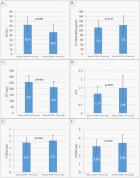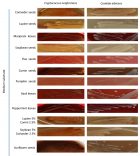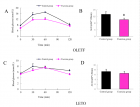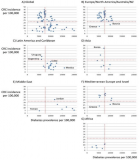Abstract
Research Article
Factors associated with zinc prescription practice among children with diarrhea who visited public health facilities in Addis Ababa, Ethiopia: A cross sectional study
Abenezer Woldegebriel*, Mesfin Beyero and Alemneh Kabeta Daba
Published: 25 March, 2021 | Volume 4 - Issue 1 | Pages: 027-032
Background: Diarrhea and nutrient deficiency worsen each other, and zinc is recommended to be included in clinical management of diarrhea. Therefore, this investigation was done to assess zinc prescription practice to children with diarrhea, identify factors associated with zinc prescription, and assess caregivers’ zinc’s perceived cost and willingness to pay for.
Methods: A health institution based cross-sectional study was done. Caretakers of 609 children with diarrhea attending health centers in Addis Ababa were included. Logistic regression was applied to identify variables associated with zinc prescription.
Results: Zinc was prescribed to 62.1% of children. About 74.9% of the caregivers were willing to pay for zinc. Previous use of zinc (AOR = 2.3; 95% CI: 1.34-4.01), exposure to zinc related message (AOR = 2.6, 95% CI: 1.53-4.60) and willingness to pay for zinc (AOR = 6.9; 95% CI: 3.84-12.66) were associated with zinc prescription.
Conclusion: Zinc was not administered to considerable proportion of children with diarrhea. Previous use of zinc, exposure to zinc related message and willingness to pay for positively contributed to zinc prescription. Health care workers shall be encouraged on zinc prescription. Intervention to increase willingness to pay for zinc and zinc benefit communication shall be strengthened in parallel with operational researches.
Read Full Article HTML DOI: 10.29328/journal.japch.1001026 Cite this Article Read Full Article PDF
Keywords:
Children; Diarrhea; Zinc prescription; Willingness to pay
References
- World Health Organization (n.d.). Diarrhoea.https://www.who.int/topics/diarrhoea/en/
- World Health Organization. Diarrhoeal disease. 2017. https://www.who.int/news-room/fact-sheets/detail/diarrhoeal-disease
- Robert EB, Saul SM, Jennifer B. Where and why are 10 million children dying every year? Lancet. 2003; 361; 2226–2334. PubMed: https://pubmed.ncbi.nlm.nih.gov/12842379/
- Liu L, Oza S, Hogan D, Chu Y, Perin J, et al. Global, regional, and national causes of under-5 mortality in 2000–15: an updated systematic analysis with implications for the Sustainable Development Goals. Lancet. 2016; 388: 3027–3035. PubMed: https://pubmed.ncbi.nlm.nih.gov/27839855/
- Roohani N, Hurrell R, Kelishadi R, Schulin R. Zinc and its importance for human health: An integrative review. J Res Med Sci. 2013; 18; 144–157. PubMed: https://pubmed.ncbi.nlm.nih.gov/23914218/
- Hannah Ritchie MR. (n.d.). Micronutrient Deficiency. https://ourworldindata.org/micronutrient-deficiency
- Solomons NW. Dietary sources of zinc and factors affecting its bioavailability. Food Nutr Bulletin. 2001; 22: 138–154.
- Federal Democratic Repulic of Ethiopia. The seqota declaration committed to ending stunting in children under two by 2030. 2019.
- Dafursa K, Gebremedhin S. Dietary Diversity among Children Aged 6-23 Months in Aleta Wondo District, Southern Ethiopia. J Nutr Metabol. 2019.
- Solomon D, Aderaw Z, Tegegne TK. Minimum dietary diversity and associated factors among children aged 6-23 months in Addis Ababa, Ethiopia. Int J Equity Health. 2017; 16: 181. PubMed: https://pubmed.ncbi.nlm.nih.gov/29025434/
- Temesgen H, Yeneabat T, Teshome M. Dietary diversity and associated factors among children aged 6–23 months in Sinan Woreda, Northwest Ethiopia: a cross-sectional study. BMC Nutr. 2018; 4: 1–8. PubMed: https://pubmed.ncbi.nlm.nih.gov/32153869/
- Gibson RS, Ferguson EL. Nutrition intervention strategies to combat zinc deficiency in developing countries. Nutr Res Rev. 1998; 11: 115–131. PubMed: https://pubmed.ncbi.nlm.nih.gov/19087462/
- Kabata A, Henry C, Moges D, Kebebu A, Whiting S, et al. Determinants and Constraints of Pulse Production and Consumption among Farming Households of Ethiopia. J Food Res. 2016; 6: 41.
- Hailu A, Henry C, Kebebu A, Whiting S. Effectiveness of the women’s development team leaders in delivering nutrition education on pulse sprouting in Southern Ethiopia. African J Food, Agri Nutrit Develop. 2020; 20: 15331–15343.
- Yetnayet M, Henry CJ, Berhanu G, Whiting SJ, Regassa N. Nutrition education promoted consumption of pulse based foods among rural women of reproductive age in Sidama zone, Southern Ethiopia. African J Food, Agri Nutrit Develop. 2017; 17: 12377–12394
- Gibson RS, Abebe Y, Hambidge KM, Arbide I, Teshome A, et al. Inadequate feeding practices and impaired growth among children from subsistence farming households in Sidama, Southern Ethiopia. Matern Child Nutr. 2019; 5: 260–275. PubMed: https://pubmed.ncbi.nlm.nih.gov/20572929/
- Sharma K, Mogensen KM, Robinson MK. Pathophysiology of Critical Illness and Role of Nutrition. Nutr Clin Pract. 2019; 34: 12–22. PubMed: https://pubmed.ncbi.nlm.nih.gov/30580456/
- Hambidge KM. Zinc and diarrhea. Acta Paediatr Suppl. 1992: 81: 82–86. PubMed: https://pubmed.ncbi.nlm.nih.gov/1421947/
- World Health Organization and United Nations Children Fund. Clinical management of acute diarrhoea acute diarrhoea. 2004.
- Federal Democratic Republic of Ethiopia. Summary and Statistical Report of the 2007 Population and Housing Census:Population Size by Age and Sex. Addis Ababa.2008.
- Lemeshow S Jr, D. W. H, Klar, J, Lwanga SK. Adequacy of Sample Size in Health Studies. Biometrics. 1991; 47: 347.
- Wang W, Vicki M. Introducing zinc through the private sector in Nepal for the treatment of childhood diarrhea. 2009.
- Pathak D, Pathak A, Marrone G, Diwan V, Lundborg CS. Adherence to treatment guidelines for acute diarrhoea in children up to 12 years in Ujjain, India - A cross-sectional prescription analysis. BMC Infectious Diseases.2011; 11: 32.
- Jamlick K. Zinc prescription in children with diarrhoea admitted to 22 Kenyan hospitals. Global Epidemiology in a Changing Environment: The Circumpolar Perspective. Ancholaske, Alaska USA. 2014.
- Winch PJ, Gilroy KE, Doumbia S, Patterson AE, Daou Z, et al. Short report: Prescription and administration of a 14-day regimen of zinc treatment for childhood diarrhea in Mali. Am J Trop Med Hyg. 2006 74: 880–883. PubMed: https://pubmed.ncbi.nlm.nih.gov/16687696/
- Macdonald V, Sanders E. Marketing Zinc for Childhood Diarrhea Treatment: Results from household and provider surveys in Benin and Uganda. 2012.
- Jamlick K. Zinc prescription in children with diarrhoea admitted to 22 Kenyan hospitals. Global Epidemiology in Chnging Environment: The Circumpolar Perspective, 2014.
- Akhter S, Larson CP. Willingness to pay for zinc treatment of childhood diarrhoea in a rural population of Bangladesh. Health Policy Plan. 2010; 25: 230–236. PubMed: https://pubmed.ncbi.nlm.nih.gov/19955094/
- Omuemu VO, Ofuani IJ, Kubeyinje IC. Knowledge and use of zinc supplementation in the management of childhood diarrhoea among health care workers in public primary health facilities in Benin-City, Nigeria. Glob J Health Sci. 2012; 4: 68–76. PubMed: https://pubmed.ncbi.nlm.nih.gov/22980153/
- Otieno GA, Bigogo GM, Nyawanda BO, Aboud F, Breiman RF, et al. Caretakers’ perception towards using zinc to treat childhood diarrhoea in rural Western Kenya. J Health Popul Nutr. 2013; 31: 321–329. PubMed: https://www.ncbi.nlm.nih.gov/pmc/articles/PMC3805881/
Figures:

Figure 1
Similar Articles
-
Congenital poisoning after maternal parenteral mercury administrationBenjamin Courchia*,Leventer Roberts Maya,Meyer John,Galvez Maida,Herrera Jaime,Rauch Daniel. Congenital poisoning after maternal parenteral mercury administration. . 2018 doi: 10.29328/journal.japch.1001001; 1: 001-005
-
The Impact of Adenotonsillectomy on Health-Related Quality of Life in Paediatric PatientsShuaib Kayode Aremu*. The Impact of Adenotonsillectomy on Health-Related Quality of Life in Paediatric Patients. . 2018 doi: 10.29328/journal.japch.1001002; 1: 006-011
-
Prevalence of ESBL urinary tract infection in childrenKhalil Salameh*,Galia ZA Awean,Hala Elmohamed,Hoor Alshmayt,Mohamed Riad Bur Omer . Prevalence of ESBL urinary tract infection in children. . 2019 doi: 10.29328/journal.japch.1001004; 2: 004-007
-
Aripiprazole-induced seizures in children with autism spectrum disorder and epilepsyMohammed MS Jan*. Aripiprazole-induced seizures in children with autism spectrum disorder and epilepsy. . 2020 doi: 10.29328/journal.japch.1001009; 3: 008-010
-
So-called idiopathic scoliosis – disfiguring deformity in children, pain problems in adults. Information about biomechanical etiology, classification and therapyTomasz Karski*. So-called idiopathic scoliosis – disfiguring deformity in children, pain problems in adults. Information about biomechanical etiology, classification and therapy. . 2020 doi: 10.29328/journal.japch.1001011; 3: 016-020
-
“Syndrome of Contractures and Deformities” according Prof. Hans Mau. Symptoms, diagnosis, treatment: Recommendations for parentsTomasz Karski*,Jacek Karski. “Syndrome of Contractures and Deformities” according Prof. Hans Mau. Symptoms, diagnosis, treatment: Recommendations for parents. . 2020 doi: 10.29328/journal.japch.1001012; 3: 021-023
-
The practice of self-medication in children by their mothers in Lubumbashi, Democratic Republic of CongoOlivier Mukuku*,Astrid Mukemo Katumbo,Thierry Sonny Tshiningi,Judith Sangwa Sinanduku,Loriot Kayinga Mudisu,Peggy Mulunda Mwadi,Oscar Numbi Luboya,Françoise Kaj Malonga. The practice of self-medication in children by their mothers in Lubumbashi, Democratic Republic of Congo. . 2020 doi: 10.29328/journal.japch.1001014; 3: 027-031
-
Premature ovarian insufficiency in children: Etiology, clinical management and treatmentChunlin Wang*,Ke Yuan. Premature ovarian insufficiency in children: Etiology, clinical management and treatment. . 2020 doi: 10.29328/journal.japch.1001017; 3: 047-055
-
A rare case report on pediatric shellfish allergyBetsy Mathew*,Ananta Jois. A rare case report on pediatric shellfish allergy. . 2020 doi: 10.29328/journal.japch.1001018; 3: 056-057
-
A girl with a stiff neckG Carlone*,A Prisco,F Vittoria,E Barbi,M Carbone. A girl with a stiff neck. . 2020 doi: 10.29328/journal.japch.1001019; 3: 058-060
Recently Viewed
-
Agriculture High-Quality Development and NutritionZhongsheng Guo*. Agriculture High-Quality Development and Nutrition. Arch Food Nutr Sci. 2024: doi: 10.29328/journal.afns.1001060; 8: 038-040
-
A Low-cost High-throughput Targeted Sequencing for the Accurate Detection of Respiratory Tract PathogenChangyan Ju, Chengbosen Zhou, Zhezhi Deng, Jingwei Gao, Weizhao Jiang, Hanbing Zeng, Haiwei Huang, Yongxiang Duan, David X Deng*. A Low-cost High-throughput Targeted Sequencing for the Accurate Detection of Respiratory Tract Pathogen. Int J Clin Virol. 2024: doi: 10.29328/journal.ijcv.1001056; 8: 001-007
-
A Comparative Study of Metoprolol and Amlodipine on Mortality, Disability and Complication in Acute StrokeJayantee Kalita*,Dhiraj Kumar,Nagendra B Gutti,Sandeep K Gupta,Anadi Mishra,Vivek Singh. A Comparative Study of Metoprolol and Amlodipine on Mortality, Disability and Complication in Acute Stroke. J Neurosci Neurol Disord. 2025: doi: 10.29328/journal.jnnd.1001108; 9: 039-045
-
Development of qualitative GC MS method for simultaneous identification of PM-CCM a modified illicit drugs preparation and its modern-day application in drug-facilitated crimesBhagat Singh*,Satish R Nailkar,Chetansen A Bhadkambekar,Suneel Prajapati,Sukhminder Kaur. Development of qualitative GC MS method for simultaneous identification of PM-CCM a modified illicit drugs preparation and its modern-day application in drug-facilitated crimes. J Forensic Sci Res. 2023: doi: 10.29328/journal.jfsr.1001043; 7: 004-010
-
A Gateway to Metal Resistance: Bacterial Response to Heavy Metal Toxicity in the Biological EnvironmentLoai Aljerf*,Nuha AlMasri. A Gateway to Metal Resistance: Bacterial Response to Heavy Metal Toxicity in the Biological Environment. Ann Adv Chem. 2018: doi: 10.29328/journal.aac.1001012; 2: 032-044
Most Viewed
-
Evaluation of Biostimulants Based on Recovered Protein Hydrolysates from Animal By-products as Plant Growth EnhancersH Pérez-Aguilar*, M Lacruz-Asaro, F Arán-Ais. Evaluation of Biostimulants Based on Recovered Protein Hydrolysates from Animal By-products as Plant Growth Enhancers. J Plant Sci Phytopathol. 2023 doi: 10.29328/journal.jpsp.1001104; 7: 042-047
-
Sinonasal Myxoma Extending into the Orbit in a 4-Year Old: A Case PresentationJulian A Purrinos*, Ramzi Younis. Sinonasal Myxoma Extending into the Orbit in a 4-Year Old: A Case Presentation. Arch Case Rep. 2024 doi: 10.29328/journal.acr.1001099; 8: 075-077
-
Feasibility study of magnetic sensing for detecting single-neuron action potentialsDenis Tonini,Kai Wu,Renata Saha,Jian-Ping Wang*. Feasibility study of magnetic sensing for detecting single-neuron action potentials. Ann Biomed Sci Eng. 2022 doi: 10.29328/journal.abse.1001018; 6: 019-029
-
Pediatric Dysgerminoma: Unveiling a Rare Ovarian TumorFaten Limaiem*, Khalil Saffar, Ahmed Halouani. Pediatric Dysgerminoma: Unveiling a Rare Ovarian Tumor. Arch Case Rep. 2024 doi: 10.29328/journal.acr.1001087; 8: 010-013
-
Physical activity can change the physiological and psychological circumstances during COVID-19 pandemic: A narrative reviewKhashayar Maroufi*. Physical activity can change the physiological and psychological circumstances during COVID-19 pandemic: A narrative review. J Sports Med Ther. 2021 doi: 10.29328/journal.jsmt.1001051; 6: 001-007

HSPI: We're glad you're here. Please click "create a new Query" if you are a new visitor to our website and need further information from us.
If you are already a member of our network and need to keep track of any developments regarding a question you have already submitted, click "take me to my Query."
















































































































































